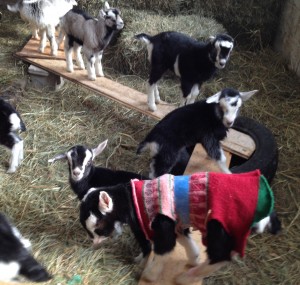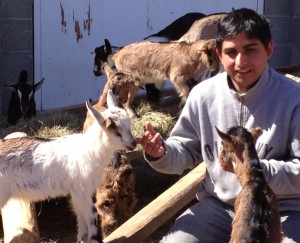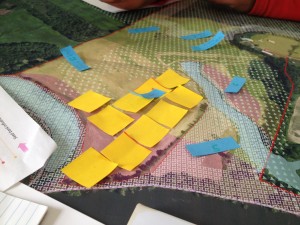By Jenn Colby
 Once in a while an idea comes along that’s just right. In the world of sustainability, the ultimate goal is to do work that supports all three (or more) legs of the sustainability “triangle”— the combination of positive social, economic and environmental outcomes. In reality, it’s great if you can find a project that combines two of those aspects. Local food access may mean supporting social networks while reducing environmental transportation impacts. Grass-based farming may mean improved biodiversity and soil cover while increasing the farmer’s net profits. Finding projects that connect two sides of the triangle are great, but real strength and stability comes when the third leg is connected.
Once in a while an idea comes along that’s just right. In the world of sustainability, the ultimate goal is to do work that supports all three (or more) legs of the sustainability “triangle”— the combination of positive social, economic and environmental outcomes. In reality, it’s great if you can find a project that combines two of those aspects. Local food access may mean supporting social networks while reducing environmental transportation impacts. Grass-based farming may mean improved biodiversity and soil cover while increasing the farmer’s net profits. Finding projects that connect two sides of the triangle are great, but real strength and stability comes when the third leg is connected.
Three years ago, Karen Freudenberger started volunteering with the Vermont Refugee Resettlement Program (VRRP), after years of working abroad largely in Madagascar. As she spent time with elders from Somalia, Bhutan, and Nepal, they shared stories of living outside, taking care of their animals, and having an important position within their communities as the providers of food. As Karen looked around Vermont, she learned that 1) Vermont produces more goat kids from the goat dairy industry than are needed, and 2) the New American communities in Vermont purchase over 3,000 goats per year through Burlington area markets alone. Most of these originate in Australia or New Zealand. The solution seemed simple: why not connect local goat production with these markets?
Not so fast. For those out there working on community volunteer projects (you know who you are), simple ideas don’t always manifest easily. They need a champion (Karen) and a support system. Early in the process, Karen reached out to the UVM Center for Sustainable Agriculture for technical assistance on teaching goats to become weed managers, husbandry and feeding issues, and business planning. She reached out to partners like Sterling College to help with a business plan and Fat Toad Farm to learn more about raising goats. She knocked on many doors with the idea that this project could help people celebrate their cultural heritage, replace imported food from across the world with a “waste” product from Vermont, bring extra money into the family, and manage natural resources widely.
 Enter the Vermont Land Trust (VLT), which was in the process of receiving a Colchester farm within close travel distance of Burlington and Winooski, and enter Chuda Dhaurali, a Bhutanese farmer who raised goats as a child before coming to the U.S. In 2013, the first goats arrived for a pilot year of establishing real numbers to compare with the estimates and practice learning how to raise and manage goats in a Northeastern climate. The Vermont Goat Collaborative, as it’s now called, was awarded a grant from the Working Lands Enterprise Fund to renovate the farm milkhouse as a state-inspected custom slaughter facility, and 84 goats were successfully raised and processed last year.
Enter the Vermont Land Trust (VLT), which was in the process of receiving a Colchester farm within close travel distance of Burlington and Winooski, and enter Chuda Dhaurali, a Bhutanese farmer who raised goats as a child before coming to the U.S. In 2013, the first goats arrived for a pilot year of establishing real numbers to compare with the estimates and practice learning how to raise and manage goats in a Northeastern climate. The Vermont Goat Collaborative, as it’s now called, was awarded a grant from the Working Lands Enterprise Fund to renovate the farm milkhouse as a state-inspected custom slaughter facility, and 84 goats were successfully raised and processed last year.
 Fast forward to February, 2014. Sitting around the farm table surveying maps and printouts are Karen and Chuda, plus an ecologist, a forester, and agroforestry/pasture staff from UVM Extension. Additional meetings will include farmer neighbors and faculty from local colleges and universities. The initial Vermont Goat Collaborative is one portion of the holistic Pine Island Farm collective, which is hosted through a partnership of VLT and Association of Africans Living in Vermont (AALV). Multiple goals are evolving for this shared land, including rice and vegetable cultivation by additional members of the New American community, protection of water quality and forested areas, maximizing the potential of young goat growth and profitability, managing for hay production, reducing invasive species, and more. This year, two additional farmers, Theoneste Rwayitare and Theogene Maharo, will be joining the Collaborative, which will allow the group to increase the total number of goats to 200. The group is working with a local dairy farmer as a partner to improve the soils and increase hay production for both goats and cows.
Fast forward to February, 2014. Sitting around the farm table surveying maps and printouts are Karen and Chuda, plus an ecologist, a forester, and agroforestry/pasture staff from UVM Extension. Additional meetings will include farmer neighbors and faculty from local colleges and universities. The initial Vermont Goat Collaborative is one portion of the holistic Pine Island Farm collective, which is hosted through a partnership of VLT and Association of Africans Living in Vermont (AALV). Multiple goals are evolving for this shared land, including rice and vegetable cultivation by additional members of the New American community, protection of water quality and forested areas, maximizing the potential of young goat growth and profitability, managing for hay production, reducing invasive species, and more. This year, two additional farmers, Theoneste Rwayitare and Theogene Maharo, will be joining the Collaborative, which will allow the group to increase the total number of goats to 200. The group is working with a local dairy farmer as a partner to improve the soils and increase hay production for both goats and cows.
As the collaboration has grown, the breadth of expectation has expanded, but so have the partners, ideas, and energy. The Pine Island Farm groups are actively striving to embody a project that provides income and cultural expression to New Americans as well as improving ecological diversity and farm productivity. This work isn’t over, and it’s not perfect—hey, even a three-legged stool tips over sometimes—but the base is strong and the potential is mighty. It’s a model of how we can approach trying to be truly sustainable in the best sense of the word. It can start with a simple idea.
Jennifer Colby is the Pasture Program Coordinator at the UVM Center for Sustainable Agriculture. Pine Island Farm was also recently featured on Vermont Public Radio.










